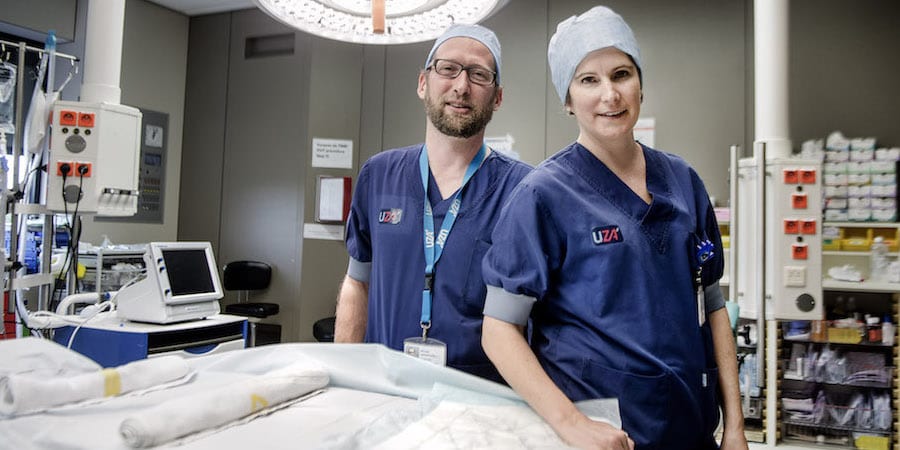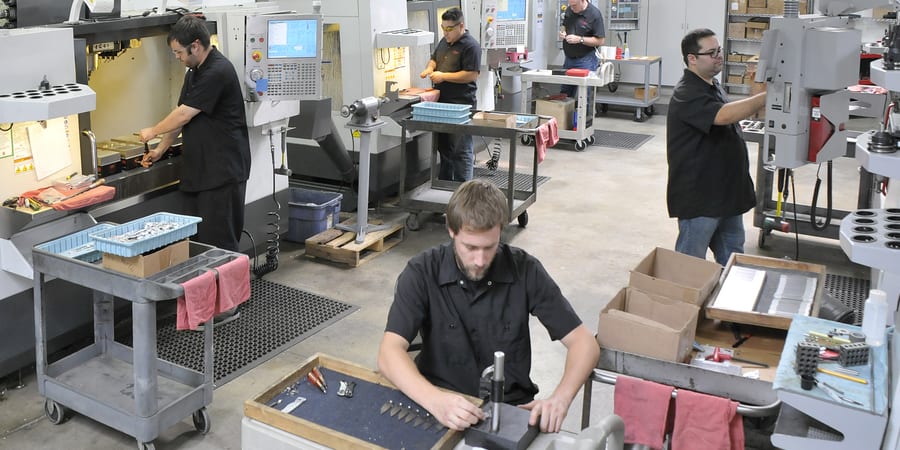
The lean journey of Antwerp University Hospital
CASE STUDY – How an improvement program of the British national healthcare system inspired a Belgian hospital to launch an organization-wide lean transformation with the active support of the HR and nursing departments.
Words: Stijn Slootmans, Project Manager UZALean, Antwerp University Hospital
Pictures courtesy of: Eric De Mildt (for many article image) and Jan Locus (for images in the body of the article)
Our lean journey began six years ago in Birmingham, UK, after visiting two English hospitals that were implementing the Productive Ward - Releasing Time to Care™ program [which we will refer to as Productive Ward].
During the debrief that followed the visits, our HR and Nursing directors convinced our CEO, Johnny Van der Straeten, that Antwerp University Hospital (UZA) needed lean thinking to stay on top of future trends and challenges, and told him they were sure we could achieve the same results we had just witnessed in England.
We realized that following the Productive Ward program would be an advantage for UZA: we could get front-line staff started with lean principles in a form that is already adapted to a healthcare environment. To support and coach ward managers, an internal lean team was created – it included myself, a colleague with a nursing background and a manager from the HR department. This team structure ensured we had the necessary clinical expertise covered, but also that support on HR issues and project coordination could be provided. Additionally, as reported in lean literature, the expected effects of this bottom-up approach are the empowerment and engagement of front-line staff as well as leadership. Other elements of the program are a focus on data-driven, systematic improvements and process stability.
We found the Productive Ward approach to be very much in line with UZA's guiding principles and vision – developing a lean mindset and holding people accountable for their own work and improvements.
Both the human resources and nursing departments considered UZALean – the name we gave to our initiative – a great opportunity to achieve their goals, and had the vision to inspire our CEO to give lean a try.
HR saw in the lean methodology a way to boost employee engagement to better support the organization, and I still remember the director, Hildegard Hermans, telling me: "There is clear evidence of a direct correlation between satisfied healthcare workers and satisfied patients. Lean empowers front-line staff to improve their work, and helping every UZA employee to make the most of this opportunity is a priority for us."
At the same time, the nursing department wanted to achieve Magnet status (Magnet is an accreditation that certifies the quality of a hospital's nursing). To do so, it would have to demonstrate a strong focus on patient outcomes, continuous improvement of patient care and nurse work environment with as goal to attract and retain nurses. The director, Paul Van Aken, saw lean as a way to operationalize the Magnet philosophy.
The lean transformation of Antwerp University Hospital started in earnest in 2011.
A NEW MINDSET AND LEADERSHIP STYLE
To introduce lean thinking in the hospital the steering committee chaired by the CEO designed a model not too different from the Lean Transformation Framework. The UZALean house has the development of a lean mindset among employees and management as its foundation.
To start off, employees were invited to take part in a short introductory session run by either the chief nursing officer or the HR director, which included a quick overview of the most important lean principles, from PDCA to people engagement. Attendees were also shown a video statement from the CEO, emphasizing that the UZALean program had nothing to do with cost-cutting but had the goal to help the hospital do better – in particular, improving the quality of care and patient safety – with the same resources. Our main goal with these sessions was to instill in our people's minds the idea that besides their normal job, every employee (caregivers, but also people working in support functions) would now be asked to actively look for improvement ideas, to provide more value to patients.

A lean mindset is not the only foundational element of the UZALean house, however. There is also lean leadership. Even though the hospital already had a strong focus on leadership development, when the lean implementation was launched we organized further training sessions for leaders at all levels – executive, middle managers and department managers, in partnership with a business school. A total of 220 managers received training, of which 50 were physicians.
The aim of the course was to develop leadership skills, but also to create a support base for the transformation. Participants were then asked to complete an improvement in their department using the A3 methodology, which meant that more than 140 improvement projects were set up. The training we offered and the UZALean program also became successful drivers for the career advancement of front-line staff and lean coaches: in the past six years, four internal lean coaches have taken up management roles.
Our Productive Ward-inspired initiative was launched in the fall of 2011 and we implemented it systematically for two and a half years in every nursing ward, including the ICU, at Antwerp University Hospital. We saw good results wherever we applied lean principles, and the steering committee soon decided to extend this approach to the surgery, emergency and outpatient departments.
As lean coaches, we translated the Productive Ward program into a standard UZALean approach, which has five fundamentals at its core:
- team involvement in improving performance;
- well-organized departments;
- work status visible at a glance;
- patient journey improvements;
- and management gemba walks.
At times, the lean team had to adapt the program to the specific circumstances of each department and provide coaching accordingly. Nevertheless, the project owner is still a person working in the department, preferably the department manager.
IMPROVING DEPARTMENT PERFORMANCE WITH ORGANIZATIONAL ALIGNMENT
During our weekly quality and patient safety huddle, which all teams take part in, front-line staff discusses ward performance and takes action where needed. To measure performance, they choose their own KPIs at each department level (for example, completeness of patient records or compliance to hand sanitizing rules). Hospital management also established a set of indicators, like overtime and absenteeism, as well as certain nurse-specific KPIs, like number of falls resulting in injury (safety incidents reported in the safety management system are discussed as a team once a month). Of course, there is also room for improvement as suggestions from the team come in.
There is a clear link between these metrics and UZA's True North, which we call the K2 model. K2 stands for knowledge and quality - both words start with the letter "k" in Dutch – but it also refers to the K2 mountain, one of the most difficult climbs in the world.
The model is an expression of our strategy for 2020, which contains the mission, vision, values and long- and short-term objectives for the organization, linked to our UZALean house. As we saw earlier, the foundations of the model are lean leadership and mindset, but we also concentrate on evidence-based practice and research. UZA has always boasted a strong focus on patient care, but the K2 model helps to better explain and verbalize our organizational objective of "providing value for patients." Management is currently creating a set of KPIs applicable to every UZA employee, which will be included in the annual evaluation and help us to measure the benefits of our increased focus on patient care.
In a bid to cascade our lean efforts and create alignment across all levels of the organization, we are asking every department to come together as a team and create a yearly plan that breaks down the hospital's goals and metrics into practical actions the department is to carry out. Follow-up on these objectives is planned with management, middle management and lean coaches every quarter, and results are discussed at a yearly meeting, during which managers look at the performance and predictions for their department with the directors. For quicker follow-up on performance, we go see. Our gemba walks are meant to encourage the creation of a culture of continuous improvement and sustainability and take place in every department according to a pre-established plan: middle management coaches front-line staff and managers every month; C-suite executives show up every quarter; the CEO visits every department at least once a year.
Management involvement ensures that there is a clear understanding of UZA's strategic plan; that everybody at all levels understands organizational objectives; and that these are translated into concrete actions people can carry out to give their contribution to True North. The achievement of the goals, however, is every team's responsibility. This duality, which is perfectly in line with our vision to achieve our results with an engaged workforce, represents the balance between top down and bottom up that we have been able to strike.

BETTER PROCESSES
But it's not all performance; we also help our teams to improve their workplace by means of the 5S methodology and visual management. To simplify the workstations in their departments, our front-line staff used things like floor marks and color codes, while to keep track of these adjustments they rely on process maps.
The fact that the improvements are based on how people actually use and interact with the workplace helps us ensure buy-in: something as simple as not having to waste time looking for a piece of equipment or for medical supplies is invaluable for a nurse, for example, which makes the benefits of the lean improvements clear to every team member.
These changes have led to remarkable results in a number of our processes: the admission of patients to the medium-care ward in coronary care takes 40% less time than before, and the same is true for preparing an IV drip. Critically, there was also an average increase of 10% in the amount of time nurses in all wards devote to direct care. In my opinion, this is a result of our implementation of 5S coupled with the fact that team issues are discussed weekly. These were the sorts of achievements that convinced the front-line staff of the benefits of lean management.
Another benefit of improving the workplace is the fact that the status of patient care is now clear to each and every caregiver. We use a web-based tool, which we created in collaboration with the IT and administration departments, to visualize patient flow. This piece of software is incredibly useful, as it helps us bring clarity over safety concerns, prevent disruption by consulting caregivers, identify potential dates of discharge and visualize the patient's journey. Visualization triggers staff to immediately react to any deviation from standards.

Perhaps, the most important outcome of the lean transformation at UZA is the fact that teams are now actively using PDCA and A3 thinking to analyze and map patient journeys and other important department processes. Our people have started collecting data to understand the current state and comparing this with the future, ideal condition of their ward or department. Root-cause analysis is now commonplace and frequent experiments and quick learning cycles have become our default way to approach change. When an ideal state is reached, we have learned to create and put in place a standard, and we use an audit to make the standard sustainable. This is also strongly linked with our JCI accreditation, which we received in the summer of 2015.
An excellent example of a process improvement that has benefited our patients is bedside shift handovers. After assessing the value that communication between shifts can bring to a patient and visiting a hospital that had already implemented shift handovers, the nursing council for patient safety (one of our four nursing councils, which give our nurses the opportunity to inform and influence department policy) decided to perform handovers between nurses at the patient's bedside. We surveyed patients and nurses after the implementation, asking them to review the new process, and we were happy to see the bedside handovers received a mean score of 8.3 out of 10 from patients. Nurses, on the other hand, gave this process improvement a mere 6.6. This score triggered the nursing council to analyze the root-cause of the problem, which led to discovering a number of practical issues that explained the resistance (for example, privacy issues or the idea of becoming "vulnerable" as a caregiver in front of patients). The nurses of the council then coached teams to find an answer to every bottleneck, so that they now have agreement on specific measures to address a specific patient situation they might encounter.
Lean has paved the way to even bigger and bolder changes, like the complete renovation of our outpatient clinic, which we just initiated and will complete in 2018. The new facility will be the result of the improvement suggestions of a lean working group and, as such, it will have the patient journey as its main focus: this means we will pay great attention to the efficient use of the space we have, minimizing waiting times and maximizing value to patients as much as we can. For example, analysis has shown us that treatment boxes were often underutilized because they were assigned to a specific medical department. When a doctor was in the operating room or on vacation, the box was simply not used, even when a doctor in another department struggled to find a place to visit a patient. Introducing generic treatment rooms means the space we have available will be used more efficiently. We are also introducing a registration kiosk and a pre-admission unit to save up time at the patient admission stage, which we found reduces overall lead-time and therefore increases the amount of value-added time in the outpatient clinic part of the patient journey. Fully implementing these changes is our big project for the next two years.
LOOKING BACK
Five years after introducing our version of the Productive Ward program in our pilot wards, UZALean continues to spread like wildfire. The first results we achieved in these wards got the attention of a lot of our colleagues: the increase of time spent on direct patient care seemed to be particularly impactful and to convince everyone that we are on the right track.
The quick wins we got at department level thanks to techniques like 5S were only the beginning. It is now time to start looking at end-to-end processes or complete patient journeys, to create even more value and move forwards with our journey. Management is the most important driver of a lean transformation, which is why we have just started a new training course for management, focusing on coaching and on inspiring the development of leadership skills.
We are still at the beginning of our lean journey, but we are definitely starting to see continuous improvement become more and more embedded in the way we work as an organization.
THE AUTHOR

Read more


SAVE THE DATE – Our editor introduces the theme of this year’s Lean Global Connection, which focuses on rethinking leadership to ensure our organizations can tackle daily issues while keeping an eye on their long-term strategy.


FEATURE – This article explains how Lean Thinking and the agile method can strengthen and optimize our digital transformation efforts.


WOMACK'S YOKOTEN - If you are going to succeed at one of your resolutions for 2016, let it be that of always starting off a lean transformation with a deep analysis of the work at a single point in your organization, and then escalating your efforts to reach all the factors influencing the work.


FEATURE – The Covid-19 pandemic has exposed all the shortcomings of our current supply chains. Lean Thinking can make them more agile, aligned and adaptive.

